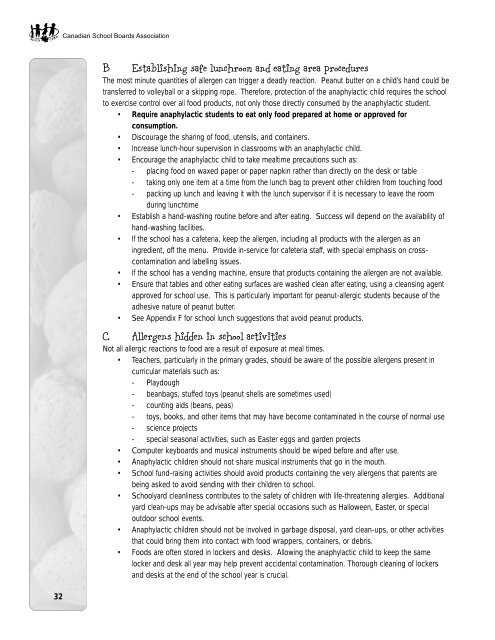Anaphylaxis - Canadian School Boards Association
Anaphylaxis - Canadian School Boards Association
Anaphylaxis - Canadian School Boards Association
You also want an ePaper? Increase the reach of your titles
YUMPU automatically turns print PDFs into web optimized ePapers that Google loves.
<strong>Canadian</strong> <strong>School</strong> <strong>Boards</strong> <strong>Association</strong>32B Establishing safe lunchroom and eating area proceduresThe most minute quantities of allergen can trigger a deadly reaction. Peanut butter on a child’s hand could betransferred to volleyball or a skipping rope. Therefore, protection of the anaphylactic child requires the schoolto exercise control over all food products, not only those directly consumed by the anaphylactic student.• Require anaphylactic students to eat only food prepared at home or approved forconsumption.• Discourage the sharing of food, utensils, and containers.• Increase lunch-hour supervision in classrooms with an anaphylactic child.• Encourage the anaphylactic child to take mealtime precautions such as:- placing food on waxed paper or paper napkin rather than directly on the desk or table- taking only one item at a time from the lunch bag to prevent other children from touching food- packing up lunch and leaving it with the lunch supervisor if it is necessary to leave the roomduring lunchtime• Establish a hand-washing routine before and after eating. Success will depend on the availability ofhand-washing facilities.• If the school has a cafeteria, keep the allergen, including all products with the allergen as aningredient, off the menu. Provide in-service for cafeteria staff, with special emphasis on crosscontaminationand labelling issues.• If the school has a vending machine, ensure that products containing the allergen are not available.• Ensure that tables and other eating surfaces are washed clean after eating, using a cleansing agentapproved for school use. This is particularly important for peanut-allergic students because of theadhesive nature of peanut butter.• See Appendix F for school lunch suggestions that avoid peanut products.C. Allergens hidden in school activitiesNot all allergic reactions to food are a result of exposure at meal times.• Teachers, particularly in the primary grades, should be aware of the possible allergens present incurricular materials such as:- Playdough- beanbags, stuffed toys (peanut shells are sometimes used)- counting aids (beans, peas)- toys, books, and other items that may have become contaminated in the course of normal use- science projects- special seasonal activities, such as Easter eggs and garden projects• Computer keyboards and musical instruments should be wiped before and after use.• Anaphylactic children should not share musical instruments that go in the mouth.• <strong>School</strong> fund-raising activities should avoid products containing the very allergens that parents arebeing asked to avoid sending with their children to school.• <strong>School</strong>yard cleanliness contributes to the safety of children with life-threatening allergies. Additionalyard clean-ups may be advisable after special occasions such as Halloween, Easter, or specialoutdoor school events.• Anaphylactic children should not be involved in garbage disposal, yard clean-ups, or other activitiesthat could bring them into contact with food wrappers, containers, or debris.• Foods are often stored in lockers and desks. Allowing the anaphylactic child to keep the samelocker and desk all year may help prevent accidental contamination. Thorough cleaning of lockersand desks at the end of the school year is crucial.


